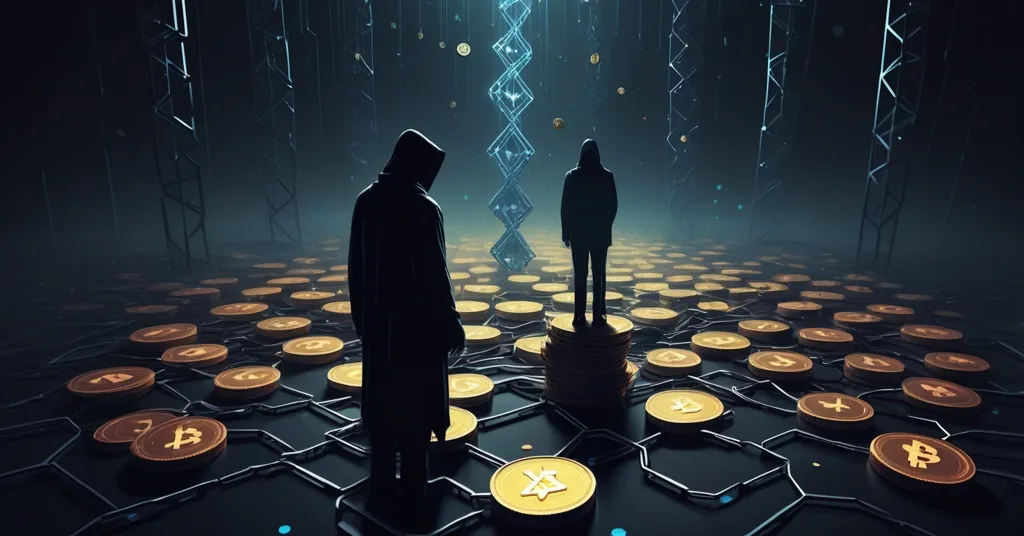Ripple’s Lost 32,569 Ledgers: A Decade-Old XRP Flaw Fuels 2025 Trust Crisis

Ripple’s Missing 32,569 Ledgers: A Decade-Old Flaw Still Haunting XRP
A server bug from Ripple’s 2012 launch erased critical data for the first 32,569 ledgers of the XRP Ledger, leaving a permanent scar on its blockchain history. As XRP surges to new heights in 2025, this unresolved gap—paired with recent moves by co-founder Chris Larsen—keeps fueling conspiracy theories and hard questions about trust in one of crypto’s heaviest hitters.
- Data Void: A 2012 server bug wiped out header data for 32,569 early XRP Ledger records, breaking the cryptographic chain.
- Transparency Crisis: This gap obscures the initial distribution of 100 billion pre-mined XRP tokens, raising accountability concerns.
- Trust on Trial: Recent $140 million XRP sales by Chris Larsen amid a rally reignite skepticism over Ripple’s shadowy start.
The Lost Ledgers: A 2012 Disaster That Still Echoes
Imagine investing billions in a currency, only to discover its origin story has missing pages—would you trust it? That’s the reality for XRP holders today, thanks to a glitch over a decade ago. When Ripple launched the XRP Ledger in June 2012, a server bug obliterated the header data for its first 32,569 ledgers, covering a critical span through December of that year. For those new to blockchain tech, ledger headers are like page numbers in a book—they hold metadata and hashes that link each ledger to the next, ensuring the entire chain can be verified as authentic. Lose them, and you’ve got a broken chain. While the raw transaction details from those early days still exist, without headers, you can’t cryptographically confirm the first 534 transactions. That’s not just a technical hiccup; it’s a foundational flaw for a blockchain now backing a $190 billion market cap asset in 2025. For a deeper dive into the technicalities of this issue, check out this explanation of the XRP Ledger bug from 2012.
Back in 2012, Ripple wasn’t just another crypto experiment—it was positioning itself as a faster, centralized alternative to Bitcoin, focused on revolutionizing payments with pre-mined tokens. Unlike Bitcoin, where coins are gradually released through decentralized mining, all 100 billion XRP tokens were created upfront by Ripple’s founders. Of these, 80% were allocated to Ripple companies for development, while 20% stayed with the founders. This pre-mining model already raised eyebrows for its lack of transparency compared to Bitcoin’s open issuance. But losing the ledger data from that inaugural six-month period? That’s like burning the receipt for a trillion-dollar deal. There’s no way to independently verify who got what or when during XRP’s genesis. You’re stuck trusting Ripple’s early team to have played fair—a tough ask in a space built on “don’t trust, verify.”
Why Ripple’s Missing Ledger Data Still Stings in 2025
Fast forward to today, and the Ripple XRP missing data mystery remains unresolved, casting a long shadow over its credibility. Those lost ledgers aren’t just ancient history; they cover the exact window when 100 billion pre-mined tokens were distributed. Without that cryptographic chain, there’s no hard proof of how much went where—whether to insiders, early investors, or other entities. This transparency gap clashes with blockchain’s core promise of immutability and traceability. Bitcoin’s entire history is an open book, every satoshi traceable to its mining origin. XRP? You’re rolling the dice on Ripple’s word for its very foundation. Curious about the significance of this issue? This discussion on why XRP Ledger’s missing data matters offers some insight.
Ripple’s CTO, David Schwartz, owned up to the mess back in 2012 on a Bitcoin forum, admitting:
“Unfortunately, due to a server bug, some history was lost. You can’t trace all the way back to the genesis ledger. You can trace back to ledger 32,570.”
He dangled a shred of hope, adding:
“All history after the beta was opened is available. All that was lost was the ledger headers, all the transactions are still available, so there’s some hope that the history may still be recovered.”
Yet, over ten years later, no dice. Another Ripple developer from the time underscored the challenge:
“There is no real way to trace back from 32,570, unfortunately. 32,569 contains the hash of 32,568 and that is definitely a much harder target to brute force.”
Let’s break that down. “Brute force” means trying every possible combination to recreate the missing headers—like guessing a password by testing every option. With missing metadata (like exact ledger heights), it’s akin to finding a needle in a digital haystack the size of Mount Everest. The computational effort required could take longer than the age of the universe, rivaling the energy demands of Bitcoin mining today. An unnamed XRPL developer echoed this in a historical thread:
“Depending on how these old transactions are stored, it might be hard to find out in which exact ledger they were actually recorded. Still, if these old transactions don’t include their ledger height, there might be quite a bit more guesswork, or brute force, required.”
Bottom line: recovery is a pipe dream without a miracle. This isn’t just a technical snag—it’s a trust killer. For a blockchain tied to a top-tier asset, having an unverifiable start is a glaring red flag. For more on the ongoing challenges with blockchain integrity, this thread on XRP Ledger recovery attempts highlights user and expert concerns.
Chris Larsen’s Sell-Off: Fueling the Conspiracy Fire
Just when you thought the Ripple transparency issues in 2025 couldn’t get murkier, co-founder Chris Larsen drops a bombshell. Amid XRP’s historic rally—up 419.6% over the past year, hitting $3.22 with a peak of $3.65 on July 18, per TheStreet—Larsen moved $140 million worth of XRP to exchanges. Nothing screams “I believe in our project” like dumping nine figures at the top, right? The timing is brutal for optics. With XRP’s market cap swelling to over $190 billion, retail investors and community watchdogs were already side-eyeing Ripple’s historical baggage. Now, a founder cashes out big during a euphoric surge? That’s jet fuel on a conspiracy bonfire. Learn more about the implications of this move in this report on Chris Larsen’s recent XRP sales.
The crypto community didn’t hold back. Twitter user Wazz (@WazzCrypto) captured the mood on July 24, 2025, with a biting remark:
“My favorite fact about $XRP is that the entire first week is missing from the ledger history and this is considered completely normal. So 32569 ledgers (read: blocks) were lost forever and there’s hundreds of Billion of Dollars of supply which u can’t determine origin.”
Wazz isn’t alone. Across Reddit threads and crypto forums, skepticism abounds—many question if Larsen’s sales tie back to untraceable early transactions from 2012. Are there hidden stashes from those lost ledgers being liquidated now? There’s no proof, but the unverifiable history leaves room for wild speculation. Add Ripple’s ongoing SEC lawsuit—still unresolved in 2025, debating if XRP is a security—and you’ve got a perfect storm of doubt. This isn’t just about one sell-off; it’s a modern echo of a credibility gap that’s festered for over a decade. For community reactions to these transparency concerns, check this Reddit discussion on Ripple’s lost data issues.
XRP’s Strengths Amid the Shadows
Let’s pump the brakes on the criticism for a moment and give credit where it’s due. Despite the XRP Ledger history gap, Ripple has carved a legitimate niche in cross-border payments—a space where Bitcoin, frankly, often stumbles due to speed and cost. XRP transactions settle in seconds for pennies, making it a darling for banks and remittance services via RippleNet. Partnerships with major players like Santander and MoneyGram showcase real-world utility, with reports estimating Ripple processes billions in transaction volume annually for over 300 financial institutions. A 2023 stat from Ripple’s own quarterly report noted over $30 billion in XRP-powered payments since inception—a number likely higher by 2025. This practical edge is why investors keep pouring in, historical warts and all, pushing that $190 billion market cap. For a detailed examination of this historical gap, see this analysis of the XRP Ledger history issue.
Unlike Bitcoin’s laser focus on being a decentralized store of value, XRP fills a transactional void, especially for tokenized assets and institutional use. It’s not trying to be Bitcoin, and that’s fine—different tools for different jobs. But let’s face the harsh reality: utility doesn’t erase a broken foundation. Blockchain’s ethos hinges on transparency and immutability. When a major player like Ripple can’t deliver that from day one, it undermines the credibility of the entire space. Mass adoption demands trust, not just fast transfers. So, while XRP’s strengths are undeniable, they don’t absolve the lingering shadows of its origins.
Broader Implications for Blockchain Trust
Ripple’s lost ledgers aren’t just an XRP problem—they’re a case study in the clash between centralized and decentralized systems. Bitcoin maximalists like myself see this as Exhibit A for why decentralization matters. Bitcoin’s blockchain is an unbroken ledger; every transaction is traceable to its mined origin through a transparent, trustless process. XRP’s pre-mined, centrally distributed model—compounded by missing data—requires faith in Ripple’s early operators. That’s antithetical to crypto’s core mission of cutting out middlemen and empowering individuals through privacy and freedom. For a broader perspective on how these issues impact trust, explore this piece on Chris Larsen’s sales and trust in XRP.
Yet, let’s not pretend altcoins like XRP or Ethereum don’t have roles to play. Ethereum’s smart contracts, despite early centralization critiques, have transparency in token issuance that XRP lacks. These platforms fill niches Bitcoin doesn’t—nor should it—address. Still, Ripple’s woes highlight a broader challenge for adoption: how do we accelerate innovation without sacrificing standards? This ties into effective accelerationism—the idea that exposing flaws in projects like XRP pushes the industry toward better, truly decentralized solutions faster. If we’re disrupting the status quo, we can’t let half-baked transparency slide.
Then there’s the SEC lawsuit hanging over Ripple, questioning XRP’s legal status as a security. Unresolved into 2025, it compounds the trust deficit by casting doubt on Ripple’s ethical and regulatory standing. For retail investors, this piles onto the ledger mystery—why bet on a coin with so many question marks? Institutional partners on RippleNet might shrug off historical flaws for operational gains, but the community isn’t so forgiving. The lesson for crypto at large is clear: centralized control and murky origins are liabilities in a space fighting for legitimacy.
What If This Stays Unresolved?
Looking ahead, what happens if Ripple never fixes this? Five or ten years down the line, will XRP’s utility in cross-border payments overshadow its shadowy start, or will persistent distrust cap its growth? As blockchain adoption expands, unresolved flaws like this could deter new entrants who demand ironclad integrity. Ripple could mitigate this by releasing any remaining transactional scraps from 2012, funding serious recovery efforts, or even commissioning third-party audits of early distributions. Why haven’t they? That silence speaks volumes. Until there’s action, XRP risks being a cautionary tale—a powerful tool with a fatal crack at its base. For more on the ongoing speculation surrounding this issue, take a look at this report on Ripple’s lost ledgers fueling conspiracies.
Key Takeaways and Questions on Ripple’s Lost Ledger Mystery
- What caused the loss of Ripple’s early XRP Ledger data?
A server bug in 2012 erased header data for the first 32,569 ledgers, severing the cryptographic chain needed to verify the blockchain’s earliest history. - Why does this gap matter for XRP transparency?
It hides the initial distribution details of 100 billion pre-mined XRP tokens in 2012, leaving no independent way to confirm allocations and raising accountability doubts. - Can Ripple recover the missing ledger headers?
Transaction data survives, but missing metadata makes reconstruction a near-impossible computational feat; over a decade of attempts has yielded no success. - How does this impact trust in Ripple and XRP?
Users must rely on Ripple’s word for early transactions without cryptographic proof, clashing with blockchain’s trustless ethos and fueling ongoing skepticism. - Why do XRP conspiracy theories persist in 2025?
Unverifiable history, centralized control, and Chris Larsen’s $140 million XRP sales amid a rally keep speculation about hidden dealings or mismanagement alive. - What can Ripple do to rebuild trust with XRP holders?
Release any remaining early data, fund aggressive recovery efforts, or allow third-party audits of historical distributions to address the transparency gap head-on.
Let’s cut the nonsense: Ripple’s lost ledgers are a black eye on XRP’s legitimacy, clashing with the principles of decentralization and transparency we fight for in this financial uprising. As we push for a world unshackled from centralized overlords, we must hold every project to a ruthless standard—even those with real utility like XRP. For every market rally or shiny partnership, unresolved flaws like this drag the entire space backward. Ripple needs to face the music, or the whispers of conspiracy will roar into a deafening storm. Until then, buyer beware—and keep demanding better. So, is XRP’s speed worth its shadowy start? That’s the $190 billion question.



